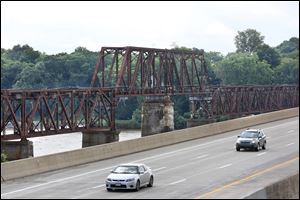
Preservation plan clears way for railroad bridge demolition
12/31/2017The formal completion of a historic-preservation plan has cleared the way for demolition of a decaying former railroad bridge next to the Ohio Turnpike.

The old Chessie railroad bridge that runs parallel to the Ohio Turnpike, over the Maumee River.
The Wood County Port Authority, which since 2011 has owned what once was the Toledo Terminal Railroad’s Upper River Bridge, and the Ohio Department of Transportation said late last week that removal likely will start during the second half of 2018.
The schedule “is still somewhat in flux,” with the port authority having obtained federal funding for the demolition but ODOT to bid out and manage the project, said Rex Huffman, the port authority’s legal counsel.
“I’m hoping to get it going earlier rather than later,” Mr. Huffman said after providing a “sometime early summer” estimate, while a spokesman at ODOT’s district office in Bowling Green predicted a late summer/early fall start.
A memorandum of agreement between the Advisory Council on Historic Preservation, the Ohio Historic Preservation Office, ODOT, and the port authority — with three other agencies as “concurring parties” — requires that the structure be documented, memorialized and, to an unspecified extent, reused after its dismantling.
The bridge once was part of the Toledo Terminal’s line around Toledo and its suburbs — the only railroad beltway in the United States to form a complete loop.
But while portions of the old Toledo Terminal remain vital parts of the city’s rail network, the Upper River bridge fell into disuse during the 1980s and since then the 1902-built bridge has deteriorated to the point that several engineering studies determined its restoration — even for use as part of a pedestrian/bicycle trail — to be cost-prohibitive.
CSX Transportation conveyed the bridge and other surplus Toledo Terminal right-of-way in 2011 to the Westside Corridor Coordinating Committee, a consortium of public agencies developing a plan to develop what is now known as the Chessie Circle Trail on that property.
ODOT’s Office of Environmental Services, meanwhile, reported in 2009 that the bridge’s swing spans, but not the five spans on either side leading up to them, were eligible for listing on the National Register of Historic Places “as a surviving example of an uncommon type of bridge technology.”
The memorandum of agreement requires:
● A documentary survey of the bridge consistent with Historic American Engineering Record standards be conducted before demolition.
● A commemorative plaque and display about the bridge and associated railroad be placed nearby.
● “Commemorative elements from the bridge” be made available for use along the Chessie Circle Trail.
● The bridge “be made available for reuse to entities that may have an interest in reusing all or part of the historic truss system.”
Mr. Huffman said Friday he was unaware of any group or individual having stepped forward to express interest in reusing any part of the bridge, but such offers could still be made before demolition starts.
Two sections of the Chessie Circle Trail have been finished, including the newest near the bridge’s Toledo end between River and Glanzman roads, which opened this year.
Long-range plans for the Chessie Circle Trail call for a replacement pedestrian bridge to be built in the same general area at some point, but in the interim the trail route could be detoured to the Maumee-Perrysburg Bridge several miles upriver.
Contact David Patch at dpatch@theblade.com or 419-724-6094.